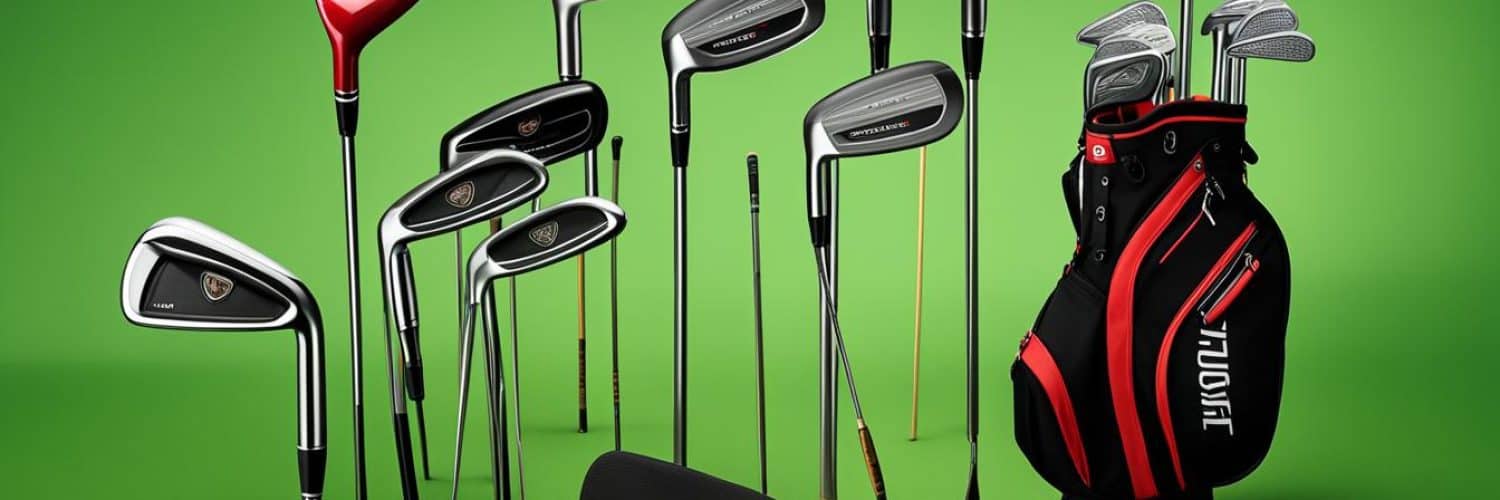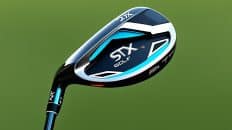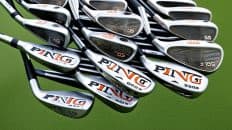Golf is a sport that requires skill, precision, and the right equipment. One essential aspect of every golfer’s arsenal is the golf club. There are different types of golf clubs, each serving a specific purpose and designed to meet the needs of different shots and playing styles.
Key Takeaways:
- There are five categories of golf clubs: woods, irons, hybrids, wedges, and putters.
- Woods are used for long-distance shots and have the largest clubheads.
- Irons are for precision and control, with smaller clubheads than woods.
- Hybrids combine the characteristics of woods and irons and provide easier shots.
- Wedges are used for high loft and short distances.
Woods
When it comes to long-distance shots in golf, woods are the go-to clubs. They are designed for strokes played from the teeing ground and are known for their ability to deliver power and distance. The clubheads of woods are the largest among all golf clubs, allowing for maximum energy transfer upon impact. Additionally, woods have the longest shafts, enabling golfers to generate greater clubhead speed. Contrary to their name, the clubheads of woods are not made from wood but rather from modern materials such as titanium or steel.
There are different types of woods available, including drivers and fairway woods. Drivers, also known as 1-woods, have the lowest loft and are primarily used for tee shots to launch the ball down the fairway with the greatest possible distance. Fairway woods, on the other hand, have higher lofts and are designed for shots played from the fairway or rough. They offer versatility and accuracy in approaching the green.
Choosing the right type of wood for your game depends on your skill level, playing style, and desired shot outcome. It is important to consider factors such as loft, clubhead material, and clubhead size before making a selection. Experimenting with different types of woods can help golfers find the club that suits their game best.
| Types of Woods | Clubhead Material | Primary Use |
|---|---|---|
| Driver (1-wood) | Titanium or Steel | Tee shots, maximum distance |
| Fairway woods (3-wood, 5-wood, etc.) | Titanium or Steel | Approach shots, shots from fairway or rough |
Irons
Irons are an essential category of golf clubs that provide golfers with the precision and control needed for approach shots and shots from the fairway. These clubs have smaller clubheads compared to woods and come in numbered sets, typically ranging from 3 to 9. Each iron in the set has a specific loft angle and length, allowing golfers to make accurate shots at various distances.
There are three main categories of irons: long irons, mid-irons, and short irons. Long irons, typically numbered 1 to 4, have less loft and are designed for longer shots. They are commonly used for tee shots on longer par-4 and par-5 holes. Mid-irons, usually numbered 5 to 7, have a moderate loft and are versatile clubs used for approach shots from the fairway or rough. Short irons, numbered 8 to 9, have a high loft and are ideal for shots requiring a shorter distance, such as approach shots to the green.
Irons are made using various materials, including stainless steel, forged steel, and carbon steel. Each material has its own unique characteristics, influencing factors such as forgiveness, feel, and distance control. Stainless steel irons, for example, are known for their durability and affordability, while forged steel irons offer a softer feel and better shot control.
By equipping themselves with a well-designed set of irons and mastering their use, golfers can navigate the course with precision and confidence, enhancing their overall performance.
Hybrids
Hybrids have revolutionized the game of golf with their unique combination of wood and iron characteristics. These innovative clubs are designed to provide golfers with the best of both worlds, offering the forgiveness and ease of hitting of woods along with the precision and accuracy of irons. They have become increasingly popular among golfers of all skill levels, including both amateurs and professionals.
One of the key advantages of hybrid clubs is their versatility. They can be used in various situations on the golf course, making them a valuable addition to any golfer’s bag. Hybrids are particularly effective when replacing long irons, as they are much easier to hit and offer better forgiveness. With hybrids, golfers can achieve higher launch angles and longer distances, making them a great choice for players looking to improve their game.
When it comes to replacing irons with hybrids, it’s important to note that hybrids are typically numbered similarly to the irons they replace. For example, a 3-hybrid would replace a 3-iron, a 4-hybrid would replace a 4-iron, and so on. By replacing long irons with hybrids, golfers can benefit from improved consistency and greater ease of use. This can lead to better ball striking and overall performance on the course.
It’s also worth mentioning that hybrids can be used effectively from a variety of lies. Whether golfers are hitting off the tee, from the fairway, or out of the rough, hybrids provide the necessary versatility to handle different situations. This makes them a valuable asset for golfers who want to adapt to changing course conditions and improve their overall scoring potential.
Additionally, hybrids offer a larger sweet spot compared to long irons, resulting in less mishits and more forgiving shots. The clubhead design of hybrids, with a low and deep center of gravity, promotes a higher launch and adds more spin to the ball. This combination of forgiveness and performance generates greater distance and accuracy, allowing golfers to have more control over their shots.
To summarize, hybrids have become an integral part of many golfers’ arsenals due to their unique blend of wood and iron characteristics. Their versatility, forgiveness, and ability to replace long irons make them a valuable option on the golf course. Whether golfers are seeking greater distance, accuracy, or playability from various lies, hybrids provide the necessary tools to enhance their game.
Wedges
When it comes to shots that require high loft and short distances, wedges are the go-to clubs for golfers. Whether it’s getting out of a sand trap or hitting a precision pitch shot onto the green, having the right wedge in your bag can make all the difference. There are different types of wedges, each with its own unique characteristics and purposes:
- Pitching Wedge: The pitching wedge is one of the most commonly used wedges. With a loft ranging from 44 to 50 degrees, it is perfect for shorter approach shots and for getting the ball up in the air.
- Sand Wedge: Designed specifically for shots out of bunkers, the sand wedge has a higher loft, usually between 54 and 58 degrees. Its wide sole and bounce help prevent the club from digging into the sand, making it easier to escape difficult lies.
- Lob Wedge: The lob wedge has the highest loft among all the wedges, typically ranging from 60 to 64 degrees. It is used for high, soft shots over obstacles like trees or when pinpoint accuracy is required. The lob wedge allows golfers to hit the ball high and land it softly on the green.
- Gap Wedge: Also known as the approach wedge or utility wedge, the gap wedge fills the gap between the pitching wedge and the sand wedge in terms of loft. It typically has a loft ranging from 50 to 54 degrees and is used for shots that require more distance control than the sand wedge but less distance than the pitching wedge.
Each type of wedge offers unique benefits and advantages, allowing golfers to tackle a variety of shots with confidence. Having the right wedges in your bag can help you improve your short game and lower your scores.
“The secret to a good short game is having confidence in your wedge shots. The right wedge can help you save strokes around the greens and set up more birdie opportunities.” – Phil Mickelson
Golf Wedge Comparison
| Wedge Type | Loft (Degrees) | Best Use |
|---|---|---|
| Pitching Wedge | 44-50 | Approach shots, mid-range shots |
| Sand Wedge | 54-58 | Bunker shots, shots from the rough |
| Lob Wedge | 60-64 | High, soft shots, shots over obstacles |
| Gap Wedge | 50-54 | Distance control, shots between pitching wedge and sand wedge |
Putters
When it comes to golf, precision and finesse play a crucial role. That’s where putters come in. Putters are the most specialized golf clubs designed specifically for rolling the ball along the ground on the putting greens. They are essential for those vital shots that can make or break your game.
Putters come in a variety of shapes, sizes, and styles to suit different golfers’ preferences and playing styles. From traditional blade putters to high-tech mallet putters, there is a wide range of options to choose from. Some golfers prefer the classic look and feel of a blade putter, while others opt for the enhanced stability and forgiveness provided by a mallet putter.
Furthermore, putters also vary in length to accommodate different golfers’ posture and stroke preferences. The standard-length putters are the most commonly used, providing a comfortable setup for many golfers. However, if you prefer a more anchored stroke, you might consider a belly putter that extends up to your belly button or a long putter that reaches beyond your chest.
Now, let’s take a closer look at the different styles of putters:
Blade Putters:
The blade putter is the traditional style that has been around for decades. It features a thin, flat clubhead with a straight or slightly curved back. Blade putters are known for their excellent feel and control, making them a popular choice among golf purists.
Mallet Putters:
Mallet putters, on the other hand, have a larger, more rounded clubhead. This design provides increased stability and forgiveness, reducing the impact of off-center strikes. Mallet putters often incorporate alignment aids and weight distribution technologies to enhance accuracy and consistency.
Insert Putters:
Some putters feature face inserts made of materials like rubber, thermoplastic elastomer, or urethane. These inserts help soften the feel at impact and can improve ball roll consistency. Golfers who prefer a softer feel and enhanced feedback may find insert putters to be their go-to choice.
Counterbalanced Putters:
Counterbalanced putters have additional weight in the grip end to shift the club’s balance point higher up the shaft. This design aims to promote a smoother, more stable stroke and can be beneficial for golfers who struggle with excessive hand movement.
No matter your preferred style or length, choosing the right putter is crucial for consistent and accurate putting. It’s always recommended to try out different putters and find the one that feels comfortable and suits your stroke mechanics.
Experimenting with different putters and seeking professional advice can help you unlock your true putting potential and improve your overall game.
Now, let’s take a look at a comparison table that outlines the key features and benefits of different putter styles:
| Putter Style | Clubhead Design | Key Features | Benefits |
|---|---|---|---|
| Blade Putters | Thin, flat clubhead | Classic look and feel, excellent control | Precision and feedback |
| Mallet Putters | Larger, rounded clubhead | Enhanced stability, forgiveness, alignment aids | Consistency and accuracy |
| Insert Putters | Face insert made of soft materials | Soft feel, improved ball roll consistency | Control and feedback |
| Counterbalanced Putters | Additional weight in the grip end | Stable stroke, reduced hand movement | Consistency and control |
Clubhead and Shaft
Golf clubs are made up of various components, each playing a vital role in the golfer’s performance. Two significant components are the clubhead and the shaft.
Clubhead
The clubhead is the part of the golf club that comes into contact with the ball during a swing. It plays a crucial role in determining the club’s characteristics, such as forgiveness, launch angle, and ball speed.
Clubheads come in different materials and shapes, each offering unique advantages:
- Titanium clubheads are lightweight and provide maximum distance due to their high strength-to-weight ratio.
- Steel clubheads offer enhanced control and feel, making them suitable for players who prioritize precision over distance.
- Composite clubheads, combining materials like carbon fiber and titanium, aim to optimize both distance and control.
Shaft
The shaft is the long, thin component that connects the grip to the clubhead. It plays a critical role in the overall performance of the golf club, affecting factors such as distance, accuracy, and feel.
Shafts can be made from different materials, each influencing the club’s characteristics:
- Steel shafts are often heavier and provide stability and control, making them popular among professional players.
- Graphite shafts, on the other hand, are lighter and offer increased swing speed and distance, making them suitable for a wide range of players.
- Composite shafts combine different materials to provide a balance of weight, feel, and performance.
Additionally, shaft length plays a crucial role in a golfer’s swing. While there is no one-size-fits-all approach, longer shafts tend to generate more distance, while shorter shafts offer better control.
To summarize, the clubhead and shaft are essential components of a golf club, each contributing to the club’s performance and characteristics. Golfers should consider factors such as material, shape, and length when selecting clubs that suit their playing style and preferences.
Types of Golfers
Golf is a sport that appeals to people of all skill levels, from beginners to professionals. Each category of golfer requires a different type of golf club set to enhance their game and accommodate their needs. Let’s explore the different types of golfers and the golf clubs that suit them best.
Beginner Golf Clubs
For those just starting their golf journey, beginner golf clubs are the ideal choice. These clubs are designed to provide forgiveness and help new golfers develop their swing technique. Beginner golf club sets typically include a driver, fairway woods, irons, wedges, and a putter. The clubs in these sets are designed to be more forgiving with larger sweet spots and more loft, making it easier for beginners to hit accurate shots.
Intermediate Golf Clubs
As golfers progress and gain experience, they may transition to intermediate golf clubs. These clubs cater to golfers who have developed a solid swing and are looking for more control and distance. Intermediate golf club sets often feature a combination of cavity-back irons, hybrids for versatility, and fairway woods with a balance of forgiveness and distance. This allows intermediate golfers to improve their skills while still benefiting from forgiveness in their shots.
Professional Golf Clubs
Professional golfers rely on high-performance golf clubs that offer precise control, consistent distance, and exceptional feel. These clubs are designed for skilled golfers who prioritize workability and shot-shaping capabilities. Professional golf club sets are typically custom-built to meet the exact specifications and preferences of individual players. Professionals often mix and match clubs from different brands to create a tailored set that complements their playing style and maximizes their performance on the course.
Custom Golf Clubs
Custom golf clubs are not exclusive to professionals. Golfers of all skill levels can benefit from clubs that are specifically tailored to their swing characteristics, body measurements, and playing style. Custom golf club sets are designed to optimize launch angle, spin rates, and overall performance based on individual requirements. These sets can include custom shafts, grips, and clubhead modifications to ensure the ideal fit and performance for each golfer.
Custom golf club sets are a great investment for serious golfers who aim to improve their game and maximize their potential on the course. Whether you are a beginner, intermediate, or professional golfer, choosing the right set of golf clubs that suits your skill level and playing style is crucial for an enjoyable and successful golfing experience.
Set of Golf Clubs
A complete golf club set consists of a combination of woods, irons, wedges, and a putter. Each type of club serves a specific purpose and is designed to provide golfers with different options for different shots. Let’s take a closer look at the components of a golf club set:
Woods
Woods are typically used for long-distance shots and are designed with large clubheads and longer shafts. They are often made of materials like titanium or steel, providing enhanced power and distance. Woods include drivers and fairway woods, and they are usually numbered based on loft angle.
Irons
Irons are versatile clubs that offer precision and control. They have smaller clubheads compared to woods and come in sets of varying numbers. Long irons, such as 3- and 4-irons, have less loft and are used for longer shots, while short irons, like 8- and 9-irons, have more loft and are ideal for shorter shots.
Wedges
Wedges are specifically designed for shots that require high loft and short distances. They offer excellent control over the ball and are commonly used for shots around the green or from sand bunkers. Different types of wedges include pitching wedges, sand wedges, lob wedges, and gap wedges.
Putter
The putter is the club used on the green to roll the ball into the hole. Putters come in various shapes, sizes, and styles, offering golfers different options for their putting stroke. The right putter can greatly impact a golfer’s ability to sink putts and lower their score.
In addition to the standard clubs mentioned above, some golfers may choose to include utility clubs in their set. Utility clubs, such as driving irons or hybrid irons, provide additional versatility by combining the characteristics of different club types. They can be used for specific shots that require more distance or control.
When it comes to the number of clubs in a set, it’s important to note that the maximum allowed under USGA rules is 14. Golfers can customize their club sets based on their preferences and playing style. Beginners or casual golfers often opt for complete sets that come with a range of clubs and accessories, while more experienced golfers may create custom sets tailored to their specific needs.
| Club Type | Number of Clubs |
|---|---|
| Driver | 1 |
| Fairway Woods | 2-3 |
| Irons | 6-8 |
| Wedges | 2-4 |
| Putter | 1 |
| Utility clubs | Varies |
Conclusion
Choosing the right golf clubs is crucial for improving your game and maximizing your performance on the course. With a better understanding of the different types of golf clubs and their uses, you can make informed shot selections and enhance your overall golfing experience.
When selecting golf clubs, it’s important to take into account factors such as your skill level, playing style, and the type of golf you play. Beginners may benefit from a basic set of clubs that provide forgiveness and ease of use, while intermediate and professional golfers may require more specialized clubs tailored to their specific needs.
To choose the right set of golf clubs, consider seeking advice from a professional club fitter who can assess your swing and recommend clubs that match your individual characteristics. Experimenting with different clubs and seeking feedback from experienced golfers can also help you find the perfect fit.
By making the right golf club selection, you can optimize your game, improve your accuracy and distance, and ultimately enhance your enjoyment of the sport. So, take the time to understand the various club categories, analyze your own playing style, and invest in a set of clubs that will take your golf game to the next level.
FAQ
What are the different types of golf clubs?
The different types of golf clubs are woods, irons, hybrids, wedges, and putters.
What are woods used for in golf?
Woods are used for long-distance shots, including strokes played from the teeing ground.
What are irons used for in golf?
Irons are used for shots that require precision and control, such as approach shots and shots from the fairway.
What are hybrids in golf?
Hybrids are a newer category of golf clubs that combine the characteristics of woods and irons.
What are wedges used for in golf?
Wedges are used for shots that require high loft and short distances.
What are putters used for in golf?
Putters are used for rolling the ball along the ground on the putting greens.
What are the components of a golf club?
The components of a golf club include the clubhead and shaft.
What are the different types of golfers?
The different types of golfers include beginners, intermediate players, and professional golfers.
What is included in a set of golf clubs?
A set of golf clubs typically includes a combination of woods, irons, wedges, and a putter.
How many clubs are allowed in a golf set?
The maximum number of clubs allowed in a golf set under USGA rules is 14.







Add comment